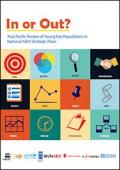Publications - Released in 2014
In Asia, it has been estimated that more than 95 per cent of all new infections among young people are occurring among young key populations at higher risk of HIV exposure. Behaviours which place young people at a higher risk for HIV infection such as unprotected paid sex, unprotected sex between males, and the sharing of contaminated injection equipment, often start at an early age. It can be difficult for young people, including those from key populations, to access HIV-related information and services. Barriers to access may hinge upon social, cultural, religious, financial, logistical, or legislative issues. These mean young key populations are more likely to have a poor understanding of HIV, inadequate access to health and support services as well as greater engagement in high-risk behaviours. In many countries this is translating into early HIV infection and the potential for escalated growth of the epidemic.
To better understand how countries are tackling the HIV epidemic among young key populations, a number of agencies agreed to partner to investigate how these groups were being addressed in national AIDS strategic plans in the Asia-Pacific region. This report is the outcome of this effort, and aims to inform country-based reviews and progress reports of current NSPs, and the development of future plans with greater attention to these populations.
Downloads
Organizations
- United Nations Educational, Scientific and Cultural Organization (UNESCO)
- United Nations Population Fund (UNFPA)
- United Nations Children’s Fund (UNICEF)
- United Nations Development Programme (UNDP)
- Joint United Nations Programme on HIV/AIDS (UNAIDS)
- Save the Children
- Global Network of People Living with HIV (GNP+)
- World Health Organization (WHO)






